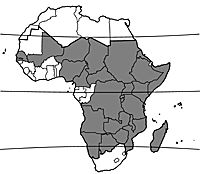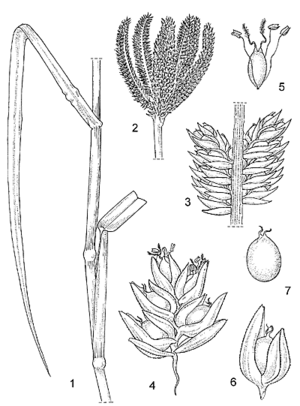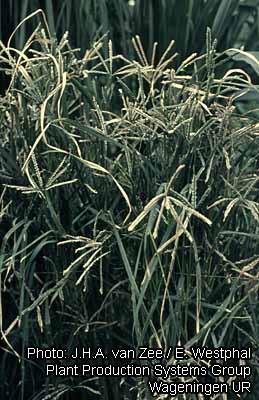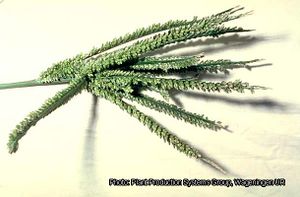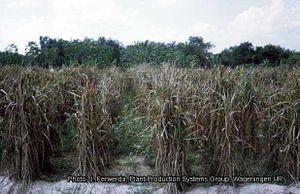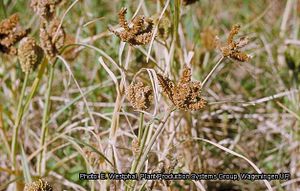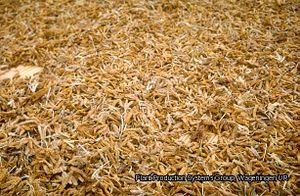Eleusine coracana (PROTA)
Introduction |
| General importance | |
| Geographic coverage Africa | |
| Geographic coverage World | |
| Cereal / pulse | |
| Medicinal | |
| Forage / feed | |
| Fibre | |
| Food security | |
| Climate change | |
Eleusine coracana (L.) Gaertn.
- Protologue: Fruct. sem. pl. 1: 8 (1788).
- Family: Poaceae (Gramineae)
- Chromosome number: 2n = 36
Synonyms
- Eleusine indica (L.) Gaertn. subsp. coracana (L.) Lye (1999).
Vernacular names
- Finger millet, African millet, koracan (En).
- Eleusine, coracan, mil rouge (Fr).
- Luco, capim colonial, nachenim (Po).
- Mwimbi, ulezi (Sw).
Origin and geographic distribution
Finger millet was domesticated in the East African highlands. The oldest known archaeological remains were excavated at Axum, Ethiopia and date back an estimated 5000 years. These resemble types of highly evolved finger millet that are still grown in Ethiopia. Cultivation of finger millet spread across the eastern and southern African savanna during the expansion of iron working technology, to eventually reach South Africa some 800 years ago. In tropical Africa it is now grown from Ethiopia and Eritrea south to Mozambique, Zimbabwe and Namibia. It is also recorded from Madagascar. Finger millet is of little importance in West Africa, but is recorded from a low-rainfall zone from Senegal eastwards, especially in Niger and northern Nigeria. Finger millet reached India 2000–3000 years ago. From India it spread across South-East Asia to China and Japan. In the United States it is grown on a small scale for bird-seed.
Uses
The principal use of finger millet in Africa is to provide malt for making local beer and other alcoholic or non-alcoholic beverages. In Ethiopia a distilled liquor known as ‘areki’ is produced from finger millet. Finger millet is also widely used as a food cereal, especially during times of scarcity. The most common use of finger millet flour is to prepare porridge, usually served with a side dish of vegetables, meat or fish. Freshly ground, slightly wet flour is made into ‘cakes’, which are wrapped in maize husks or banana leaves and roasted. Raw ‘cakes’ can be stored for several days; when needed, water is added to form a refreshing thin gruel. Flour is also pounded with bananas and the mixture is made into flat cakes that are fried in oil or baked in a dry pan.
Finger millet straw is used as forage for cattle, sheep and goats. It produces excellent hay, and in India it is cultivated as a fodder grass. In Uganda the by-products of finger millet beer production are fed to chickens, pigs and other animals. Finger millet is used medicinally, e.g. the seed as a prophylaxis for dysentery. In southern Africa the juice of a mixture of finger millet leaves and leaves of Plumbago zeylanica L. are taken as an internal remedy for leprosy. Finger millet straw is used for thatching and plaiting, and in China for papermaking. In Sudan the leaves are made into string.
Production and international trade
In trade and production statistics, finger millet is usually combined with other millets, such as pearl millet (Pennisetum glaucum (L.) R.Br.), foxtail millet (Setaria italica (L.) P.Beauv.) and proso millet (Panicum miliaceum L.). The estimated world area of finger millet is about 3 million ha yielding about 2.5 million t of grain annually. India is the largest producer. The total area planted annually in Africa is fairly constant, and slightly less than 1 million ha. Major producers in Africa are Ethiopia, Uganda, Malawi and Zimbabwe. In Africa finger millet grain is produced for local consumption. Surpluses are sold in local markets. International trade, even among neighbouring countries in Africa, is negligible.
Properties
Whole grain of finger millet contains per 100 g edible portion: water 10.9 g, energy 1377 kJ (329 kcal), protein 7.4 g, fat 1.3 g, carbohydrate 77.7 g, fibre 4.3 g, Ca 397 mg, P 190 mg, Fe 17.1 mg, β-carotene traces, thiamin 0.18 mg, riboflavin 0.11 mg and niacin 0.8 mg (Leung, Busson & Jardin, 1968). The essential amino-acid composition per 100 g food is: tryptophan 107 mg, lysine 213 mg, methionine 229 mg, phenylalanine 383 mg, threonine 310 mg, valine 487 mg, leucine 701 mg and isoleucine 324 mg (FAO, 1970). Whole grain is used in grinding, resulting in a high fibre content of the flour, making it hard to digest. For food, white-coloured grain is preferred. The more bitter dark-coloured grain is preferred for beer-making. In malting, finger millet grain has a higher enzyme activity than all other major cereals except barley, making it very suitable for brewing. Finger millet straw has an in-vitro digestibility of 40–60%.
Description
- Robust, free-tillering, tufted annual grass up to 170 cm tall; stem slender, erect or geniculately ascending, glabrous and smooth, sometimes branching, rooting at lower nodes; root system shallow, branched, fibrous.
- Leaves alternate, distichous, simple and entire; leaf sheath flattened, overlapping, split along the entire length; ligule 1–2 mm long, fimbriate; blade linear to linear-lanceolate, up to 75 cm × 2 cm, usually folded, scabrous above.
- Inflorescence a terminal digitate panicle, often with one or a few branches (‘thumbs’) below the main cluster of 4–19 branches (‘fingers’); branches slender to robust, linear to oblong, up to 24 cm long, reflexed when slender or straight to incurved at the tip when robust, sometimes with secondary branches, each branch with 60–80 spikelets.
- Spikelets ovoid-ellipsoid, up to 10 mm × 4 mm, mostly arranged in two rows along one side of the rachis, (3–)6–9(–12)-flowered; lower glume 1–4 mm long, with a 3-veined keel, upper glume 2–5 mm long, with a (3–)5–7-veined keel; florets bisexual, but terminal ones sometimes sterile or male, arranged in 2 opposite rows; lemma narrowly ovate, 2–5 mm long, palea slightly shorter than lemma; stamens 3; ovary superior, with 2 free styles ending in plumose stigmas.
- Fruit a grain with free, soft fruit wall (utricle), 4–7 per spikelet, more or less globose, up to 2 mm in diameter, white, red, brown or black; pericarp remaining distinct during development and at maturity appearing as a papery structure surrounding the seed.
Other botanical information
Eleusine comprises about 10 species, distributed in the tropical and subtropical parts of Africa, Asia and South America. The probable wild ancestor of finger millet is Eleusine africana Kenn.-O’Byrne (wild finger millet), commonly considered as a subspecies of Eleusine coracana (subsp. africana (Kenn.-O’Byrne) Hilu & de Wet) because it is also tetraploid (2n = 36) and crosses with finger millet produce fertile hybrids. It is an aggressive colonizer and forms large continuous populations in disturbed habitats, from where it is still harvested as a wild cereal in times of scarcity. It is a noxious weed of agriculture in Africa and invades fields of finger millet where, although predominantly self-fertilized, it occasionally crosses with the cereal to form extensively variable, weedy hybrid swarms.
Primitive finger millet cultivars resemble wild finger millet in inflorescence morphology but lack the ability of natural seed dispersal. They are characterized by inflorescences with spreading branches that are straight or slightly incurved at the tip when mature. These cultivars are widespread in Africa and are also grown in southern and eastern India.
A second group of highland African and Indian cultivars is also characterized by spreading inflorescence branches. Cultivars from East Africa typically have inflorescence branches that are up to 24 cm long, while others from East Africa and from southern India have 10–18 cm long inflorescence branches. Cultivars from Africa commonly have more slender inflorescences than those from India, allowing the branches to become reflexed at maturity. Individuals in fields of these cultivars sometimes have their spikelets arranged in clusters along the rachis.
A morphologically distinct group of cultivars is widely grown from Ethiopia to Zambia. These cultivars are characterized by spreading inflorescence branches with large, narrowly lanceolate spikelets that are arranged in two even rows along one side of the rachis. Morphologically related finger millets are grown in the mountains of eastern India, but in these cultivars the large spikelets are irregularly arranged and essentially surround the rachis.
The most advanced cultivars have highly proliferated inflorescence branches that are clumped together to form a fist-like structure. These cultivars are grown across the range of finger millet cultivation in Africa and the Indian sub-continent. The most commonly grown finger millet cultivars in Africa and India have much smaller inflorescences with more or less spreading branches that may become somewhat incurved or reflexed at maturity.
Growth and development
Finger millet seeds lack dormancy. However, they will not germinate in soil that lacks sufficient moisture to support seedling growth. Seedlings are sensitive to drought, but mature plants go dormant during short periods of drought and produce new tillers when conditions become favourable again. Plants tiller strongly and root from lower nodes, and provide excellent protection against soil erosion. Time from planting to flowering is 50–120 days; the complete crop cycle is 3–6 months. Flowering on individual inflorescences lasts for 8–10 days and proceeds from top to bottom on branches. Finger millet is predominantly self-pollinated, with about 1% out-crossing. Heavy rain at flowering reduces seed set. Finger millet follows the C4 photosynthetic pathway.
Ecology
Finger millet grows best at an average temperature around 23°C. In eastern and southern Africa finger millet is grown from sea-level up to about 2500 m altitude, most commonly at 1000–2000 m. It is mostly grown in areas with 750–1200 mm of rainfall during the growing season. The minimum rainfall for finger millet is 300–500 mm, but below 750 mm sorghum and pearl millet are more commonly grown because of their superior drought tolerance. Finger millet is a short-day plant with a critical daylength mostly close to 12 hours.
Finger millet grows on a range of soils, but prefers fertile, well-drained, sandy to sandy-loam soils with reasonable water-holding capacity. It prefers a pH of 5–7, but tolerates very alkaline (pH 11) soils. It does not tolerate waterlogging.
Propagation and planting
Finger millet is propagated from seed. The weight of 1000 seeds is 2–3 g. Fields are prepared by hoe or animal-drawn plough. To control weeds, fields may be ploughed at the onset of rains, weeds are allowed to germinate and the fields are ploughed a second time or even as many as six times, before the cereal crop is planted. Harrowing before planting also helps to reduce weeds. Seeds are broadcast or planted in rows behind the plough. Seed rates up to 35 kg/ha may be used when the crop is broadcast; in row planting seed rates are only 3–10 kg/ha. In row planting, seeds are sown 2–3 cm deep in rows 20–35 cm apart. As soon as convenient, seedlings are thinned to 5–12 cm apart within the row. In India seeds are sometimes germinated in nurseries, and the seedlings planted in the field when they are 3–4 weeks old. Although labour intensive, this practice provides fresh cereal grain well before direct-sown finger millet matures. Alternatively, finger millet may be sown or planted 1–2 weeks before the expected onset of rain.
Finger millet is often intercropped with other cereals, pulses or vegetables. In Ethiopia sole cropping of finger millet is common. In Africa finger millet is grown most commonly by smallholders.
Management
Weeds are a major problem in finger millet, the first two weeks after germination being critical. Several rounds of manual weeding are common, requiring much labour. When finger millet is planted in rows, animal-drawn weeders are often used. Finger millet responds well to fertilizer. Recommended rates of application are 40–60 kg N, 26–40 kg P and 30–50 kg K per ha. Smallholders, however, can rarely afford chemical fertilizers. Finger millet also responds well to the addition of organic manure or ash. In parts of Africa finger millet is grown in a shifting-agriculture system, e.g. in the ‘chitemene’ system in Zambia. In Kenya and Tanzania it is often grown as the first crop after clearing the land, when weed pressure is low and soil fertility relatively high. Finger millet is commonly grown in rotation with other annual crops, preferably pulses. In Uganda it is grown after tobacco or cotton.
Diseases and pests
Finger millet is relatively free of diseases and pests. The most serious disease is head blast caused by the fungus Magnaporthe grisea (synonym: Pyricularia grisea). It attacks finger millet across its range of cultivation. All aerial parts are affected from seedling to maturity. Serious reduction in yield occurs when inflorescences are infected during grain development. Control methods include crop rotation and the use of tolerant or resistant cultivars. Bipolaris nodulosa (synonym: Helminthosporium nodulosum) causes a dark brown leaf blight and foot and root rot, whereas Helminthosporium leucostylum causes leaf shredding, seedling blight and head blight.
Insect pests include shoot fly (Atherigona soccata), stem borers, caterpillars, grasshoppers and locusts; the phytophagous ladybird (Epilachna similis) sporadically causes serious damage. Quelea birds are pests in some areas. Major weeds of finger millet in tropical Africa include wild finger millet, Eleusine indica (L.) Gaertn. and Brachiaria deflexa (Schumach.) Robyns. These species are difficult to distinguish from finger millet in early stages of development and almost impossible to weed out successfully. The broad-leafed weed Guizotia scabra (Vis.) Chiov. is a problem in Ethiopia, but is commonly weeded out by hand. The root parasite Striga hermonthica (Delile) Benth. occurs across the range of finger millet cultivation in Africa, but rarely seems to cause serious problems. Stored finger millet is insect-resistant due to the grains being too small for weevils to squeeze inside, and can be stored for several years without serious damage.
Harvesting
In Africa finger millet fields are often harvested in several rounds to prevent loss of grain through shattering because of uneven ripening. Harvesting usually starts when grain of the earliest genotypes contains about 10% moisture. Inflorescences are individually cut and allowed to dry.
Yield
The average finger millet grain yield under local practices of agriculture in tropical Africa is 0.25–1.5 t/ha. With improved cultivars, optimal weed control and use of fertilizers yields of up to 5 t/ha are obtained under experimental conditions. Straw yields range from 1–2.5 t/ha for rainfed crops to 9 t/ha for irrigated crops.
Handling after harvest
Finger millet grain is stored after threshing or in inflorescences that are threshed as needed. Threshing is usually by beating the inflorescences with a stick. Grain is ground on a grinding stone or in a mill. A little water may be added during the grinding process to keep the grains together and to avois fragmentation of the bran. The coarse bran is winnowed off and may be used in making beer. Straw is commonly grazed by cattle. In East Africa grain to be used in brewing is typically soaked in water and left for 2–3 days to germinate, after which the germinated seeds are ground, mixed with fried fermented maize, sorghum or finger millet flour, and placed in water to further ferment for 2–5 days.
Genetic resources
Major finger millet germplasm collections are being maintained and evaluated by ICRISAT Asia Center (Patancheru, India), with selected duplicate specimens at ICRISAT Southern and Eastern Africa (Bulawayo, Zimbabwe and Nairobi, Kenya) and SADC (Bulawayo, Zimbabwe). Germplasm collections include about 2800 accessions from Africa and about 2100 from Asia. Major African collections are from Uganda, Zimbabwe, Kenya, Malawi and Zambia, and most Asian collections are from India and Nepal. A large collection (about 2000 accessions, mainly from Kenya) is maintained at the National Genebank of Kenya, Muguga. Another extensive collection, numbering 1300 accessions from Ethiopia, is maintained by the Institute of Biodiversity Conservation (IBC), formerly known as Plant Genetic Resources Center of Ethiopia (PGRC/E), in Addis Ababa, Ethiopia. Germplasm from the rest of tropical Africa and tropical Asia needs to be collected.
Breeding
Finger millet breeders need to identify resistance to head blast and to incorporate such resistance into cultivars with acceptable yield. Screening for resistance is making progress. Progress is also being made to reduce susceptibility to lodging and shorten the growing cycle, and to increase tolerance to moisture stress and yield under traditional farming systems. Hand emasculation and pollination of finger millet florets are tedious and hamper rapid progress through trait recombination. A male sterile line has been developed in Zimbabwe. Improved cultivars released in Africa include ‘Tadesse’, ‘Padet’ and ‘Boneya’ in Ethiopia, ‘P-283’, ‘P-224’, ‘ P-221’ and ‘Serere-1’ in Kenya, ‘Engeny’, ‘Serere-1’, ‘Gulu-E’ and ‘P-224’ in Uganda, ‘Steadfast’ and ‘M-144’ in Zambia and ‘FMV-1’ and ‘FMV-2’ in Zimbabwe.
Finger millet has limited levels of polymorphism for DNA-based markers within the cultivated and wild species. A genetic map based on restriction fragment length polymorphism (RFLP) and amplified fragment length polymorphism (AFLP) markers is being constructed using crosses between finger millet and wild finger millet.
Prospects
The area under finger millet cultivation varies from year to year in both Africa and Asia. The trend, however, shows stability or increases in most countries where finger millet is a staple cereal. A major constraint in finger millet production is the high labour requirement, especially for weeding, harvesting and milling. However, its excellent storage quality and the fact that in Africa it is preferred over other cereals in the production of local beer assure finger millet a place in agriculture.
Major references
- Anand Kumar, K. & Renard, C., 2001. Finger millet. In: Raemaekers, R.H. (Editor). Crop production in tropical Africa. DGIC (Directorate General for International Co-operation), Ministry of Foreign Affairs, External Trade and International Co-operation, Brussels, Belgium. pp. 9–16.
- Bisht, M.S. & Mukai, Y., 2002. Genome organization and polyploid evolution in the genus Eleusine (Poaceae). Plant Systematics and Evolution 233(3–4): 243–258.
- Burkill, H.M., 1994. The useful plants of West Tropical Africa. 2nd Edition. Volume 2, Families E–I. Royal Botanic Gardens, Kew, Richmond, United Kingdom. 636 pp.
- de Wet, J.M.J., 1995. Finger millet. In: Smartt, J. & Simmonds, N.W. (Editors). Evolution of crop plants. 2nd Edition. Longman Scientific & Technical, Harlow, United Kingdom. pp. 137–140.
- de Wet, J.M.J., 2000. Millets. In: Kiple, K.F. & Ornelas, K.C. (Editors). The Cambridge world history of food. Cambridge University Press, Cambridge, United Kingdom. pp. 113–121.
- de Wet, J.M.J., Prasada Rao, K.E., Brink, D.E. & Mengesha, M.H., 1984. Systematics and evolution of Eleusine coracana (Gramineae). American Journal of Botany 71(4): 550–557.
- Hilu, K.W. & Johnson, J.L., 1997. Systematics of Eleusine Gaertn. (Poaceae: Chloridoideae): chloroplast DNA and total evidence. Annals of the Missouri Botanical Garden 84: 841–847.
- Hilu, K.W., de Wet, J.M.J. & Harlan, J.R., 1979. Archaeobotanical studies of Eleusine coracana ssp. coracana (finger millet). American Journal of Botany 66(3): 330–333.
- Jansen, P.C.M. & Ong, H.C., 1996. Eleusine coracana (L.) Gaertner cv. group Finger Millet. In: Grubben, G.J.H. & Partohardjono, S. (Editors). Plant Resources of South-East Asia No 10. Cereals. Backhuys Publishers, Leiden, Netherlands. pp. 90–95.
- Prasada Rao, K.E. & de Wet, J.M.J., 1997. Small millets. In: Fuccillo, D., Sears, L. & Stapleton, P. (Editors). Biodiversity in trust: conservation and use of plant genetic resources in CGIAR Centres. Cambridge University Press, Cambridge, United Kingdom. pp. 259–272.
Other references
- Acland, J.D., 1971. East African crops: an introduction to the production of field and plantation crops in Kenya, Tanzania and Uganda. FAO, Rome, Italy/Longman, London, United Kingdom. 252 pp.
- Clayton, W.D., Phillips, S.M. & Renvoize, S.A., 1974. Gramineae (part 2). In: Polhill, R.M. (Editor). Flora of Tropical East Africa. Crown Agents for Oversea Governments and Administrations, London, United Kingdom. 273 pp.
- Cope, T., 1999. Gramineae (Arundineae, Eragrostideae, Leptureae and Cynodonteae). In: Pope, G.V. (Editor). Flora Zambesiaca. Volume 10, part 2. Royal Botanic Gardens, Kew, Richmond, United Kingdom. 261 pp.
- Davie, O. & Gordon-Gray, K., 1977. Tropical African cultigens from Shangweni excavations. Natal Journal of Archaeological Sciences 4: 153–162.
- Dida, M.M., Gale, M.D. & Devos, K.M., 2001. Exploitation of grass comparative maps in the analysis of finger millet. In: Tefera, H., Belay, G. & Sorrells, M. (Editors). Narrowing the rift: research and development in tef. Proceedings of the international workshop on tef genetics and improvement, Debre Zeit, Ethiopia, 16–19 October 2000. EARO, Addis Ababa, Ethiopia. pp. 267–274.
- Doggett, H., 1998. Small millets - a selective overview. In: Seetharam, A., Riley, K.W. & Harinarayana, G. (Editors). Small millets in global agriculture. Proceedings of the first international small millets workshop, Bangalore, India, October 29 – November 2, 1986. Aspect Publishing, London, United Kingdom. pp. 3–17.
- FAO, 1970. Amino-acid content of foods and biological data on proteins. FAO Nutrition Studies No 24, Rome, Italy. 285 pp.
- Harlan, J.R., de Wet, J.M.J. & Stemler, A.B.L., 1976. Plant domestication and indigenous African agriculture. In: Harlan, J.R., de Wet, J.M.J. & Stemler, A.B.L. (Editors). Origins of African plant domestication. Mouton Publishers, The Hague, Netherlands. pp. 3–19.
- Hilu, K.W. & de Wet, J.M.J., 1976. Domestication of Eleusine coracana. Economic Botany 30: 199–208.
- Hilu, K.W. & de Wet, J.M.J., 1976. Racial evolution in Eleusine coracana ssp. coracana (finger millet). American Journal of Botany 63(10): 1311–1318.
- Hussaini, S.H., Goodman, M.M. & Timothy, D.H., 1977. Multivariate analysis and the geographic distribution of the world collection of finger millet. Crop Science 17: 257–263.
- Kennedy-O’Byrne, J., 1957. Notes on African grasses. 29. A new species of Eleusine from Tropical and South Africa. Kew Bulletin 11: 65–72.
- Leung, W.-T.W., Busson, F. & Jardin, C., 1968. Food composition table for use in Africa. FAO, Rome, Italy. 306 pp.
- McDonough, C.M., Rooney, L.W. & Serna-Saldivar, S.O., 2000. The millets. In: Kulp, K. & Ponte, J.G. (Editors). Handbook of cereal science and technology. 2nd Edition. Marcel Dekker, New York, United States. pp. 177–201.
- Ministry of Agriculture and Rural Development, 2002. Field crops technical handbook. 2nd Edition. Ministry of Agriculture and Rural Development, Nairobi, Kenya. 219 pp.
- National Research Council, 1996. Lost crops of Africa. Volume 1: grains. National Academy Press, Washington D.C., United States. 383 pp.
- Phillips, S.M., 1972. A survey of the genus Eleusine in Africa. Kew Bulletin 27(2): 251–270.
- Phillips, S., 1995. Poaceae (Gramineae). In: Hedberg, I. & Edwards, S. (Editors). Flora of Ethiopia and Eritrea. Volume 7. Poaceae (Gramineae). The National Herbarium, Addis Ababa University, Addis Ababa, Ethiopia and Department of Systematic Botany, Uppsala University, Uppsala, Sweden. 420 pp.
- Riley, K.W., Gupta, S.C., Seetharam, A. & Mushonga, J.N. (Editors), 1993. Advances in small millets. Oxford & IBH Publishing, New Delhi, India. 557 pp.
- Weber, S.A., 1991. Plants and Harappan subsistence: an example of stability and change from Rojdi. Wetview Press, Boulder. Colorado, United States. 200 pp.
Sources of illustration
- Jansen, P.C.M. & Ong, H.C., 1996. Eleusine coracana (L.) Gaertner cv. group Finger Millet. In: Grubben, G.J.H. & Partohardjono, S. (Editors). Plant Resources of South-East Asia No 10. Cereals. Backhuys Publishers, Leiden, Netherlands. pp. 90–95.
Author(s)
- J.M.J. de Wet, Department of Crop Sciences, Urbana-Champaign, Turner Hall, 1102 South Goodwin Avenue, Urbana, IL 61801, United States
Correct citation of this article
de Wet, J.M.J., 2006. Eleusine coracana (L.) Gaertn. In: Brink, M. & Belay, G. (Editors). PROTA (Plant Resources of Tropical Africa / Ressources végétales de l’Afrique tropicale), Wageningen, Netherlands. Accessed 18 December 2024.
- See the Prota4U database.

